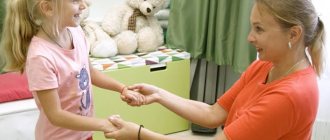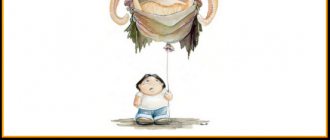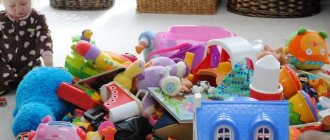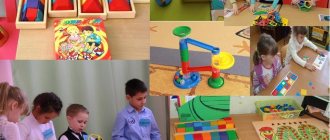Causes of children's fears
The basis for the fear of certain situations and objects is the mental characteristics of a particular child:
- impressionability;
- gullibility;
- wild fantasy;
- increased level of anxiety.
The causes of fears in children lie in the external environment, while the strongest influence is exerted by such factors as upbringing, and relationships with parents become the source of neuroses in the child.
The causes of children's fears are divided into the following groups:
- Negative experiences are situations experienced by a child that caused him emotional trauma, for example, a dog attack. Correcting fears in children of this kind is practically impossible; over time they turn into phobias;
- intimidation is a designed situation used by parents or educators to correct a child’s behavior;
- overly anxious parents create fears and anxiety in the child;
- the behavior of parents, showing their superiority and strength, gives rise to fearfulness in the child and a feeling of constant expectation of bad things;
- films and computer games showing scenes of violence;
- mental disorders, for example, neurosis or neuropathy;
- intra-family relationships, for example, conflicts between parents, constant quarrels and scandals, divorce of parents, manipulation of a child in order to influence the spouse and others.
FEATURES OF FEARS
Children express their fears in different ways, depending on their age and emotional development. This could be severe fear, constant fear of something, or affective fear - arising against the background of emotional instability. It is the most powerful and can manifest itself in the form of shock, horror, and hysterical crying.
A child may complain to adults that he is afraid of something, or he may keep everything to himself (especially if he is afraid of being misunderstood, of hearing reproaches, ridicule and condemnation). But alarming symptoms will still be present. The baby becomes fearful, withdrawn, nervous, apathetic, may have difficulty falling asleep or sleep lightly, and will constantly cling to his mother.
Hidden anxiety that does not find a way out or understanding is the most dangerous for the delicate child’s psyche. It is this that most often leads to the appearance of lingering fear, which is beyond the baby’s control. This leaves an imprint on the formation of the child’s character, prevents productive communication with others, and reduces adaptability to changes in the external environment. Ultimately, chronic fears affect the child’s future: his socialization, relationships with the opposite sex, and colleagues at work.
Pathogenesis
The explanation for the manifestations of fears in children is associated with age-related mental changes. The main role is played by the child’s fantasy and imagination; under their influence, external information is transformed into new images. The manifestation of fantasy begins at the age of 2-3, reaching a peak in preschool or primary school age. Children's fears are more intense, varied and unusual than any other. The child is not able to evaluate the situation critically and objectively evaluate his emotions, which is why fears so easily arise and become stronger in the child’s mind.
The content side of fear characterizes a significant area of a child’s life for each specific age period, for example, infancy - fear of separation from mother, preschoolers - fear of the dark, animals or fictional characters, schoolchildren - social fears.
Classification
Perhaps the most widespread division of fears in children is:
- biological - based on the instinct of self-preservation;
- social – based on interpersonal contacts.
Children's fears are classified according to the object of manifestation, causes, duration of manifestation and characteristics, as well as intensity.
The most common classification identifies the following types:
- super valuable. They appear as a result of the work of fantasy and are considered the most common;
- obsessive. They are based on a specific situation in life and give rise to panic, for example, fear of dogs or heights;
- delusional. Cannot be explained logically.
General information
Fear as the body's reaction to an imaginary/real danger is the basis of the instinct of self-preservation and mobilizes a person to escape and fight. A specific difference between children's fears is the lack of connection with an actual threat. They arise on the basis of information received from outside and are transformed by fantasy and imagination. Prevalence reaches 90%. The severity varies, in most cases the fear is superficial and disappears on its own; in 1-1.5% of children, phobias develop - emotional disorders that require treatment. Epidemiological indicators are higher in girls. Predisposing factors are the age of the parents over 35 years, raising an only child, limited contacts with peers.
Symptoms of fears in children
At different ages, children show fears and anxiety in different ways. Symptoms characteristic of a newborn are restlessness, throwing back of arms, shuddering, general tension. Fears in children under six months of age are usually caused by a loud sound or bright light, the rapid approach of something large and unfamiliar, or loss of support. From 6-7 months to three years, there is a fear of loneliness from the mother’s long absence. From 8 months to one and a half years - fear of strangers.
Starting from the age of 2, a child may be afraid of certain objects, objects or situations. After 3 years, children begin to fear punishment or lack of attention from parents, due to the onset of the age of conscious interpersonal contacts.
Preschool age is characterized by fears such as darkness, judgment of others, fear of fairy-tale or fictional characters, dangerous objects and objects. At primary school age, fears of an interpersonal nature appear - public speaking, getting a bad grade, condemnation, ridicule, rejection.
At the age of 6 years, fears of accidents, disasters of various types, illnesses, fires and even death may begin to appear. Under the influence of fear, a child often loses his appetite, sleep is disturbed, and various pains appear, for example, muscle, headache, heart, and joint pain.
Complications
The most difficult and dangerous complication of childhood fear is its transition to a state of phobia. They are expressed in intense reactions of the body in the form of anxiety and panic. They are characterized by persistent irrational behavior in response to situations or objects that do not pose a real threat. Phobias cannot be corrected, unlike fears.
Children's fears can turn into the form of obsessive-compulsive neurosis - obsessive repetition of actions and thoughts. Under the influence of childhood fears in adolescence, character traits of suspiciousness, uncertainty and anxiety appear. Thus, the lack of real help and attention from parents, teachers and psychologists in children creates restrictions in behavior in the form of avoiding certain situations, as well as difficulties in social adaptation.
General status information
Fear is a natural human instinct that arises as a response to a threat, a possible danger. In childhood, due to developed imagination and emotional instability, such fears in most cases are far-fetched and have no basis in reality. However, this condition is very common, is a threat to the child’s psyche and requires mandatory intervention from specialists. Childhood fear left to chance can subsequently become the cause of a real phobia, which will persist throughout the rest of life.
Diagnosis of children's fears
Diagnosis of fears in children is in the nature of a clinical conversation. A child, as a rule, after meeting and establishing contact, does not hide his worries, openly talking about situations that cause anxiety.
The diagnostic process of the intensity of fear and anxiety is based on psychodiagnostic techniques:
- survey - for each age category, specific questionnaires and forms of interaction with specialists have been developed, for example, for teenagers - without contact with a specialist, and for preschool children - in the form of a personal conversation;
- Projective methods are used to detect unconscious fears hidden by defense mechanisms. Used in the diagnosis of preschool children. These are forms such as drawing tests, situation design tests and diagnostic fairy tales. The absence of structured questions in them allows you to create an atmosphere of trust between the patient and the specialist and deceive the body’s defense mechanisms, as well as overcome the patient’s fear of condemnation.
Contacting specialists
The presence of fears in a child is a reason to contact doctors - a psychologist, psychiatrist, psychotherapist. JSC “Medicine” (clinic of Academician Roitberg) receives highly qualified specialists in this field. Here, children's health is treated as the most important mission, so consultations are conducted by doctors of the highest category with extensive experience. They know almost everything about children's health and the specifics of diseases in children. The clinic's doctors protect children's health 365 days a year. We are located in the very center of Moscow.
Method
The study involved 72 fourth-grade students at a Moscow gymnasium (35 girls, 37 boys). The study was conducted in November 2005 in the middle of the school day in a quiet environment.
The procedure for administering the school anxiety test was quite standard. The test was administered in groups of no more than 15 people, in writing by a school psychologist with whom the respondents had a friendly relationship. The survey was carried out during school hours.
Treatment of fears in children
Helping young patients overcome their fears is based on creating a positive home environment to maintain feelings of safety and calm. Psychotherapy is used as an additional treatment for fears in children. It is aimed at awareness and transformation of emotions of the negative spectrum: fear, anxiety, worry.
The best effect is obtained from complex therapy, which includes:
- family counseling. Its goal is to identify the reasons that contribute to the emergence and maintenance of fear in a child. Here there is a discussion of methods of raising and leisure of children, as well as features of relationships within the family. The specialist should give parents recommendations on ways to communicate with the child and how to correct parental behavior. This stage is designed to establish comfortable home conditions for correcting fears in children;
- psychotherapy in this case is exclusively individual in nature. Through conversation in a confidential environment, fears are initially discussed. Confidential dialogue relieves emotional tension. Next comes the period of processing fears. The method of fairy tale therapy is appropriate here, with the help of which a fairy tale is composed about fear, where it is defeated, or its visual vestment using modeling/drawing, as a result, fear must be ritually destroyed or remade;
- drug therapy becomes necessary in advanced forms and the presence of complications. The beginning of taking sedatives coincides with the beginning of complex treatment, while the methods of administration and dosage are determined individually by the attending physician.
Thus, timely contact with specialists for treatment of childhood fears contributes most of the success in the fight against fear in a child. However, to identify it, parents must be as attentive as possible to their child.
Identifying an anxious child in a group
Work with preschoolers can also be carried out in group classes. One of the ways to identify anxious children is to determine signs of fear according to the system created by G. Lavrentieva and T. Titarenko. The questionnaire includes 20 main points, each of which requires specific supervision of a specialist over children.
The specialist assesses whether a particular preschooler can:
- Play without getting tired.
- Complain when he has nightmares.
- Be subject to frequent mood changes.
- Have problems with appetite.
- Hold back tears during conflicts.
- Have problems sleeping.
To indicate the answers to the points, a table is built with the names of the children. The specialist puts a “plus” or “minus” next to each question. The total number of characters in the column of each test taker is counted. The level of anxiety determines the number of “+”:
- 1-6 – low;
- 7-14 – average;
- 15-20 – high.
This technique is ineffective for individual diagnosis. Its task is to identify anxious children, and not to find out the specifics of their fears.
Prevention of children's fears
Preventing fears in children is half the success in the fight against their occurrence.
To prevent the development of fears in their own child, parents should adhere to the following rules:
- establishing and maintaining a trusting relationship with the child;
- rejection of the line of upbringing in the form of parental dominance;
- refusal to use physical force;
- refusal to show one’s own worries and fears;
- proper organization of the child’s leisure time.
Proper leisure time for a child should meet the following principles:
- maximum outdoor games, creative activities and team communication;
- refusal to watch TV and computer games;
- minimizing the time when the child is alone.
Such simple measures can forever rid your child of worries and fears, unnecessary concerns and fears. The fullness of your child’s personality in adulthood depends on the serenity of childhood, which is why the problem of childhood fears is so important and relevant. Parents must be very attentive and correct with their children.
How to make an appointment with a doctor
The main principle of work of JSC "Medicine" (clinic of academician Roitberg) is to protect the health of young patients. Qualified psychologists and pediatricians are ready to offer you adequate treatment methods to restore health to children and peace of mind to parents. To get advice from the specialist you are interested in, you need to make an appointment. This can be done through the online form on the website, by phone 8+7 (495) 995-00-33, or during a personal visit to the clinic at the address: 2nd Tverskoy-Yamskaya lane, 10, Mayakovskaya metro station.










